Avoiding debt traps is essential for maintaining financial health. In today’s world, understanding how to avoid debt traps can help safeguard your future.
Many individuals unknowingly fall into these financial pitfalls, which can lead to overwhelming stress and long-lasting consequences.
Understanding Debt Traps
Understanding debt traps is crucial for maintaining your financial well-being.
A debt trap occurs when an individual borrows money and finds it difficult to repay, leading to a cycle of accumulating debt.
This usually starts with taking on loans or credit that seem manageable at first but quickly becomes overwhelming.
Why Debt Traps Happen
Many people fall into debt traps due to various reasons. Sometimes, unexpected expenses, like medical bills or car repairs, create a financial burden.
Other times, individuals may overspend on credit cards, thinking they will manage the repayments later.
The Psychological Impact
Debt traps can have a profound psychological impact.
Stress and anxiety often accompany financial struggles, leading to further poor decisions as individuals may try to escape their situation through more borrowing.
Who is at Risk?
Anyone can fall into a debt trap. However, those with lower incomes, lack of financial literacy, or limited access to financial resources are at greater risk.
Understanding your financial situation is the first step to avoiding debt traps.
Recognising Warning Signs
Recognising the warning signs of a debt trap is vital.
For instance, if you are constantly borrowing to pay off existing debt or if your minimum payments are low but your balance remains high, you may be in a debt trap.
It’s essential to monitor your financial habits to identify these signs early.
By understanding what debt traps are and how they occur, you can take proactive steps to prevent falling into financial distress.
Awareness and education empower you to make informed financial decisions that protect you from the pitfalls of debt.
Common Types of Debt Traps
There are several common types of debt traps that individuals often encounter. Recognising these traps can empower you to make informed financial decisions.
Below are some common types of debt traps:
1. Credit Card Debt
One of the most prevalent forms of debt trap is credit card debt. Many individuals tend to overspend using credit cards, believing they will manage repayments.
High interest rates can make this type of debt challenging to pay off.
2. Payday Loans
Payday loans are short-term loans that come with extremely high interest rates. Borrowers often resort to these loans during financial emergencies.
However, they can quickly lead to a cycle of debt, where one loan is taken to pay off another.
3. Personal Loans
While personal loans can be useful for consolidating debt or funding large purchases, they can also lead to a debt trap if you borrow more than you can afford to repay.
Always evaluate your ability to repay before taking out a personal loan.
4. Student Loans
Student loans are another common debt trap. Many graduates find themselves overwhelmed with repayments post-studies, especially if they struggle to find a well-paying job.
Understanding the terms and long-term impacts of student loans is vital.
5. Auto Loans
Auto loans can become a financial burden if not managed correctly.
Many individuals choose to purchase cars that are beyond their budget, leading to long-term payments that can impact overall financial health.
6. Home Equity Loans
Home equity loans allow homeowners to borrow against their home’s value.
While this can be beneficial if used wisely, it can also lead to losing your home if repayments become unmanageable.
Being aware of these common types of debt traps can help you prevent falling into financial distress.
Taking proactive measures to understand and manage your finances is key.
How to Identify Debt Traps Early

Identifying debt traps early can save you from financial hardship. Here are some ways to recognise the warning signs:
1. Monitor Your Spending Habits
Keep track of your monthly expenses and compare them to your income.
If you find yourself consistently spending more than you earn, it’s a clear sign that you might be heading towards a debt trap.
2. Check for Rising Balances
Watch your credit card and loan balances closely.
If you notice that your balances are increasing instead of decreasing, this is a strong indication that you could be falling into a debt trap.
3. Look for Dependence on Minimum Payments
If you are only able to make minimum payments on your credit cards, it may take you longer to pay off the debt.
This situation can lead you to accumulate more interest, trapping you further in debt.
4. Evaluate Loan Terms
When taking out loans, always read the terms carefully. Be cautious of loans with high interest rates or hidden fees, as these can quickly lead you into a debt trap.
5. Listen to Your Stress Levels
If financial stress weighs heavily on your mind, it might be time to reassess your financial situation.
Constant worry about money could indicate that you are entrenched in a debt cycle.
6. Seek Advice Regularly
Talking to a financial advisor can help you evaluate your financial health.
Professional advice is often necessary to recognise debt traps that you might not see on your own.
By actively monitoring these signs, you can identify potential debt traps early and take steps to avoid them, ensuring a healthier financial future.
Practical Tips to Avoid Debt Traps
Avoiding debt traps requires practical strategies that can help you stay financially healthy. Here are some effective tips:
1. Create a Budget
Establishing a budget is the first step towards managing your finances. Track your income and expenses to understand where your money goes each month.
This insight can help you identify unnecessary expenses that can be cut.
2. Build an Emergency Fund
Having an emergency fund is crucial. Aim to save three to six months’ worth of living expenses.
This fund can help you manage unexpected costs without resorting to high-interest loans or credit cards.
3. Limit Credit Card Usage
To prevent accumulating credit card debt, consider limiting or avoiding their use.
Use cash for everyday purchases to better manage your spending and reduce the temptation to overspend.
4. Shop Smart
Before making any purchases, ask yourself if it is necessary. Consider making a shopping list to avoid impulse purchases.
Look for discounts or compare prices to ensure you’re getting the best deals.
5. Pay Off Debt Aggressively
If you already have debt, focus on paying it off as quickly as possible. Start with the debts that have the highest interest rates.
Consider using methods like the snowball or avalanche method to manage your repayments.
6. Educate Yourself on Financial Literacy
Improving your financial literacy can empower you to make better choices regarding loans and credit.
Look for resources, workshops, or online courses that teach vital money management skills.
7. Seek Professional Help if Needed
If you find yourself struggling to manage your finances, don’t hesitate to seek advice from a financial professional.
They can offer tailored solutions and support to help you prevent falling into debt traps.
By implementing these practical tips, you can establish a strong foundation for financial stability and avoid potentially harmful debt.
The Role of Credit Scores in Debt Traps
Credit scores play a significant role in determining your financial health and can greatly impact your exposure to debt traps. Here’s how:
1. Understanding Credit Scores
A credit score is a numerical representation of your creditworthiness, ranging typically from 300 to 850.
It is based on various factors, including your payment history, amounts owed, length of credit history, types of credit used, and new credit inquiries.
2. The Importance of a Good Credit Score
A good credit score can make it easier for you to secure loans and credit at lower interest rates.
Conversely, a poor credit score may result in higher interest rates or even loan rejections, leading you to seek more expensive financing options that can create debt traps.
3. High-Interest Rates and Debt Traps
When lenders see a low credit score, they may offer loans with higher interest rates to compensate for the perceived risk.
These elevated costs can quickly lead you into a debt trap, as your repayments might exceed your budget or ability to manage.
4. Accessibility to Credit
A poor credit score can restrict access to various financial products.
When traditional financing methods are not available, individuals often resort to payday loans or other high-interest options, increasing the risk of falling into debt traps.
5. Tracking Your Credit Score
It’s essential to regularly check your credit score.
Understanding your financial standing allows you to take necessary steps, such as paying off debts or correcting errors on your credit report, to improve your score.
6. Strategies for Improving Your Credit Score
Improving your credit score involves consistent, responsible financial behaviour.
Ensure that you pay your bills on time, reduce your overall debt, and avoid opening multiple new credit accounts at once.
By recognising the role of credit scores in potential debt traps, you can take actionable steps to enhance your financial health and mitigate risks.
Seeking Help: Resources for Debt Management

Finding resources for debt management can significantly help you avoid debt traps and regain control over your finances. Here are some options to consider:
1. Financial Counselling Services
Many non-profit organisations offer financial counselling services.
Certified counsellors can provide personalised advice, budgeting skills, and help you create a plan to manage or reduce your debt effectively.
2. Debt Management Plans (DMP)
Debt management plans allow you to consolidate your debt into a single payment.
Working with a credit counselling agency, they can negotiate with creditors on your behalf to lower interest rates and monthly payments.
3. Online Resources and Tools
There are various online platforms that provide budgeting tools, financial education, and debt tracking applications.
Websites like MyMoney.gov or National Foundation for Credit Counseling (NFCC) offer valuable resources to help you better manage your finances.
4. Community Workshops
Local community centres and libraries often host free workshops on financial literacy.
These workshops can teach you about budgeting, saving, and understanding credit, which are essential skills for avoiding debt traps.
5. Credit Unions
Credit unions typically offer lower interest rates on loans and have less strict lending criteria compared to traditional banks.
If you’re facing financial challenges, consult with your local credit union about potential loan options or personal finance advice.
6. Professional Financial Advisers
For more comprehensive help, consider hiring a certified financial adviser.
They can assess your financial situation holistically and help you create a long-term strategy for managing debt and building savings.
7. Support Groups
Joining a support group can provide emotional assistance.
Connecting with others who are facing similar challenges can help reduce stress and provide accountability in your financial journey.
Utilising these resources can give you the support needed to tackle debt and improve your financial health effectively.
Long-Term Strategies for Financial Health
Long-term strategies for maintaining financial health are essential to avoid falling into debt traps. Here are some effective methods:
1. Live Below Your Means
To ensure long-term financial stability, practice living below your means.
This means spending less than you earn and avoiding lifestyle inflation even when your income increases.
2. Create a Comprehensive Budget
A well-planned budget helps you track your income and expenses.
Allocate your funds wisely to cover needs, savings, and debt repayment, which will promote future financial health.
3. Build a Strong Emergency Fund
Having an emergency fund is crucial. Aim to save at least three to six months’ worth of expenses to cover unexpected financial setbacks without resorting to debt.
4. Invest for the Future
Consider investing in a diversified portfolio. This could include stocks, bonds, or mutual funds.
Investing can help your money grow over time and provide a safety net for future financial needs.
5. Focus on Continuous Learning
Improve your financial literacy by reading books, attending workshops, or taking online courses.
The more you know about managing money, the better equipped you will be to make sound financial decisions.
6. Avoid Impulsive Purchases
Before making any purchase, especially large ones, ask yourself if it is necessary. This practice can prevent unnecessary spending and help you stick to your budget.
7. Regularly Review and Adjust Financial Goals
Set clear financial goals and regularly review them. As your circumstances change, adjust your goals and strategies to remain on track towards achieving long-term financial health.
By incorporating these long-term strategies into your financial habits, you can cultivate a healthier financial future and effectively avoid debt traps.
In Conclusion: Safeguarding Your Financial Future
Understanding and avoiding debt traps is crucial for maintaining financial health.
By recognising the common types of debt traps, being aware of the role of credit scores, and implementing practical tips, you can protect yourself from financial burden.
Utilising resources for debt management and focusing on long-term strategies will empower you to make informed decisions about your finances.
Building a solid foundation with a budget, emergency fund, and continuous education will secure your path towards a prosperous financial future.
By taking proactive steps today, you can ensure that you are well-equipped to navigate financial challenges and achieve lasting stability.






